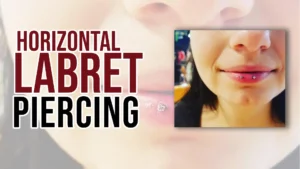Getting a body piercing is an exciting and fun experience for many people. Some people may find it scary and frightening. The practice of body piercing dates back centuries.
What if we told you that the oldest piercing found was on a mummified person over 5,000 years old? Like tattoos and other forms of body modification, piercing is now a form of fashion. Globally, it is also becoming common among young men and women.
Many types of piercings are available. But if you’re looking for something new, we recommend the Ashley piercing.
What is an Ashley Piercing?
With Ashley’s piercings, a single puncture is made through the center of the lower lip, going through the inner side of the mouth. One of the most popular lip piercing styles is the vertical labret, an adaptation.
A vertical labret pierces the lower lip from the bottom through the top. In Ashley’s piercings, only one end can be seen after the piercing is placed in the mouth. The labret stud or gemstone is often used to fix Ashley’s piercings.
Procedure to Get Ashley Piercing:
Ashley Piercing starts with sterilizing the tools and jewelry. Like any invasive body modification, Ashley’s piercing is used in the procedure. The next step is to clean the tools and then your lips. Ensure that any infectious or harmful bacteria are removed from the piercing area. You must wash your mouth and lower lip with water and disinfectant.
The piercer uses a surgical pen to mark the needle’s entry and exit points. When piercing, masters use either a straight needle or a threaded needle. The lower lip will be held in place with a tool that dentists use to cut pain; the piercing process is done. The jewelry is inserted immediately after your skin is opened.
It is always wise to have the procedure done by a professional piercer. Ensure that the piercer is certified. You can also check if the local health department inspects the piercer shop. Read online reviews to double-check the piercer’s reputation.
How Much Does Ashley’s, Piercing Hurt?
One of the most painful lip piercing procedures is the Ashley piercing. It is common for people who have undergone this painful procedure to experience it. Also, face the painful swelling due to the placement of the piercing. The piercing is also in the center of the lower lip, with numerous nerve endings contributing to this.
Among all kinds of piercings, lip piercings are the most prone to infection. As a result, they’re more likely to be in contact with saliva, food, makeup, and other bacteria-infested objects. Early detection of infections is essential.
Piercings it is critical to prevent them from becoming more serious. It is common for infected areas to experience throbbing, swelling, and redness, in some cases, with white discharge. Visit a doctor or a skin specialist if you think you have an infection.
Ashley Piercing Healing and Aftercare
Make sure you take proper care of your piercings since they are open wounds. This type of piercing generally takes 3 to 4 months to heal.
Following strict aftercare, rules are recommended for people who have undergone this piercing. You have to follow these rules, which are stated below:
- Ensure you maintain proper oral hygiene. Don’t touch the piercing with dirty hands, clothes, or things.
- When drying your wound, it’s essential to use disposable paper products. Such products as cloth towels can snag on jewelry and injure you.
- For a few days, avoid spicy and acidic foods and beverages.
- At least twice a day, clean the piercing with a saline solution.
- You should avoid chewing gum, tobacco, and other bacteria-containing foods.
- Aftercare sprays should be used after piercings. These sprays contain sea salt and lysozymes to boost healing and prevent infections.
What Is Jewelry Material Used for Ashley Piercings?
1. Surgical stainless steel
Steel that is suitable for surgical use. Stainless steel is a common material for piercing jewelry. While it is safe, it does contain nickel which can cause piercing infections. You can use stainless steel jewelry if you are sure you do not have nickel piercings.
2. Gold
Choosing 14-karat gold jewelry is essential if you love gold jewelry. Then, the metal will be too soft and may become a breeding place for bacteria.
3. The titanium metals
Regarding jewelry materials, titanium offers maximum safety. Suppose you’re worried about allergic reactions. There is no nickel in this metal, soit won’t tarnish. Due to its lightweight nature, it will not irritate your skin.
4. Sterling silver, pure and simple
Sterling silver is another great jewelry choice. It is a popular breeding ground for bacteria since it is not a pure metal and is too soft. This is because your professional piercer may not talk about it at first.
Conclusion:
You may become addicted to piercings if you see the beautiful jewelry others wear. It would be best if you chose jewelry for Ashley’s piercing. Ashley’s provides the right size and metal, so it does not irritate your skin. Some prefer larger gemstones, but daintier labret stud ends offer a cute aesthetic.
It is recommended that you avoid this piercing if you have oral issues or weak enamel. To ensure a successful piercing, choose a trusted, established piercer. Also, you will be able to determine whether to get pierced with the help of this ultimate guide to Ashley Piercing.
FAQs:
Is Ashley’s piercing harmful to teeth?
The pierced jewelry should be worn during the first two weeks after your piercing heals, as this piercing has a higher chance of breaking gem teeth, leaving scars, and rejecting gems. It should not be seen in lazy aftercare practices.
Can you replace the Ashley jewelry on your own?
The top part of the jewel needs to be removed, and the new jewel is screwed in. Removing the piece of jewelry placed by the piercer is not necessary.





